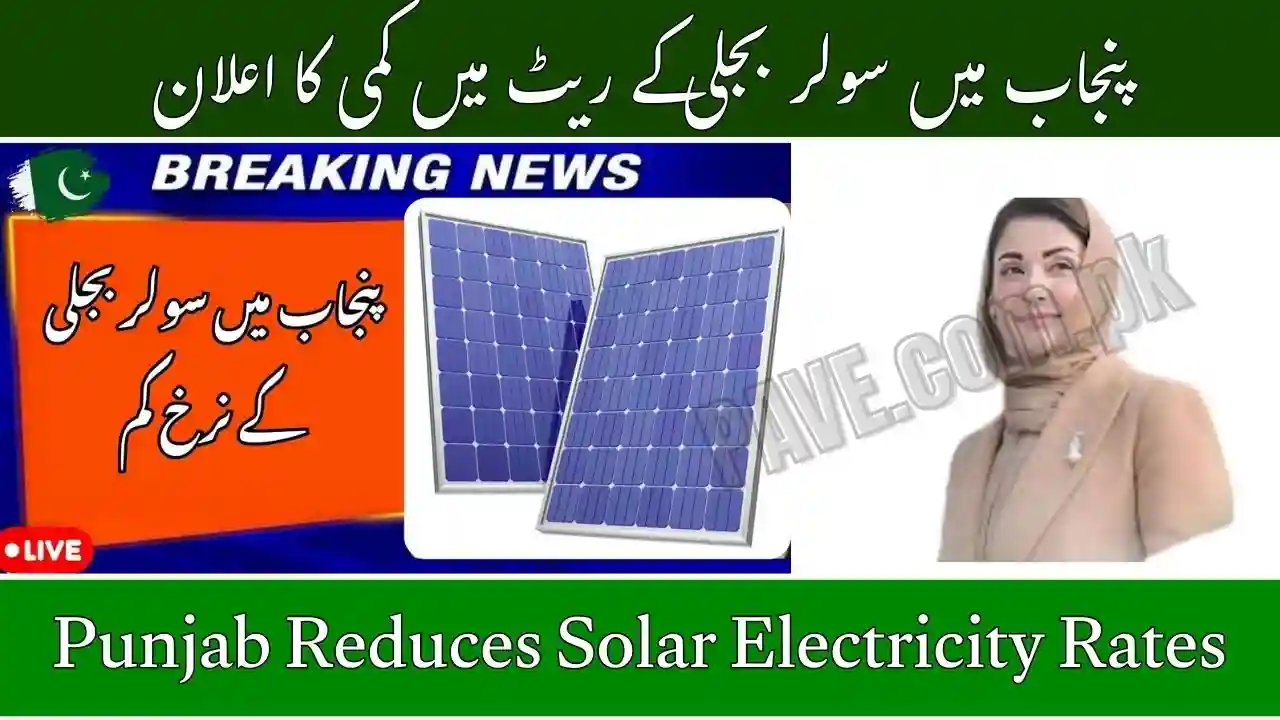Punjab Reduces Solar Electricity Rates for Consumers in October 2025

Punjab Reduces Solar Electricity Rates for Consumers in October 2025 burden on households and promoting clean energy adoption, the Government of Punjab has officially reduced solar electricity rates for consumers starting October 2025. The move is being celebrated by homeowners, businesses, and farmers alike who have long demanded affordable alternatives to rising grid electricity prices. With fuel costs and import bills straining the national economy, Punjab’s latest tariff reduction is not just a relief package—it is a strategic push towards energy independence. Government officials confirmed that the revised rates apply to both net metering users and upcoming solar installation projects under provincial subsidy schemes.
Punjab Reduces Solar Electricity Rates for Consumers in October 2025 but struggled to recover their investment due to fluctuating buy-back rates and inconsistent billing policies. The new pricing structure changes that narrative entirely. Under the revised tariff, consumers selling excess units to the grid will now receive a guaranteed rate between Rs. 18 to Rs. 22 per unit, compared to the previous average of Rs. 10 to Rs. 12 per unit. This means that a standard 5kW home-based solar setup could now generate up to Rs. 15,000 to Rs. 20,000 per month in offset savings or income—cutting electricity bills by 70% in many cases.
Industry experts believe that this decision will accelerate the shift from conventional power to renewable energy far faster than anticipated. With over 300 sunny days annually, Pakistan has one of the strongest natural potentials for solar energy production in Asia. Yet adoption remained slow due to high installation costs and uncertain tariff policies. Punjab’s new rate reduction provides long-term security to consumers, giving them confidence that their investment in solar will generate stable returns. In addition, special incentives have been announced for agricultural tube wells, school buildings, and industrial rooftops, further widening the impact.
Read Also: How to Check BISP 8171 Payment Status Online in 2025 – Complete Step-by-Step Guide
Another major win for the public is the launch of a Zero-Interest Solar Financing Scheme in collaboration with Bank of Punjab (BoP) and Punjab Energy Department. Under this scheme, households consuming up to 500 units per month can apply for 3kW to 5kW solar systems on installments, payable over 3 to 5 years without markup. Combined with the reduced net-metering rates, consumers can pay off their solar panels directly from their bill savings—making the transition extremely accessible even for middle-income families.
Punjab Reduces Solar Electricity Rates for Consumers in October 2025 the introduction of Smart Solar Billing, allowing real-time tracking of electricity generation, consumption, and sell-back status through mobile apps. This digital transparency is expected to eliminate billing disputes and increase trust between consumers and DISCOs (Distribution Companies). The government has further announced that import duty on solar inverters and panels will remain reduced to keep installation prices stable during this policy rollout.
Check Also: Breaking News: 16,000 Seats Still Vacant Under Private Hajj Scheme 2025
The Punjab Reduces Solar Electricity Rates for Consumers in October 2025 solar rate reduction is also expected to benefit small businesses, petrol pumps, cold storages, and medical clinics, which face extremely high daytime consumption rates. By switching to rooftop solar, these establishments can now operate with predictable cost margins, helping stabilize the economy at the micro level. Experts predict that Punjab may achieve 20% renewable energy penetration by 2027 if this policy remains consistent.
Benefits of Solar Rate Reduction in Punjab October 2025:
- ✅ Lower electricity bills for households and businesses
- ✅ Faster return on investment for solar installations
- ✅ Increased income from excess unit sell-back
- ✅ Interest-free financing options for low-income families
- ✅ Reduced load on national grid and fuel imports
- ✅ Cleaner and more sustainable energy ecosystem
Punjab solar rates 2025 FAQs:
- When will the new solar rates be implemented?
The revised rates are applicable from October 1, 2025 across Punjab. - Who can benefit from this rate reduction?
All net-metering users, new solar applicants, farmers, businesses, and institutions. - What is the new buy-back rate per unit?
Rates range between Rs. 18 to Rs. 22 per unit, depending on region and DISCO. - Can I apply for installments on solar panels?
Yes, under the Zero-Interest Solar Financing Scheme by Bank of Punjab. - Is there any upfront subsidy available?
Yes, certain categories like farmers and schools receive upfront subsidies. - Will old net-metering users automatically get revised rates?
Most will be adjusted automatically, but disputed cases may need reapplication. - Do I need approval from NEPRA or only WAPDA/DISCO?
Net metering approval is managed by DISCO under NEPRA guidelines. - What is the average cost of a 5kW solar system in Punjab?
After subsidy, it ranges between Rs. 650,000 to Rs. 800,000. - How much can a 5kW system generate monthly?
Approximately 600 to 750 units, depending on sunlight and panel quality. - Can commercial properties also benefit?
Yes, commercial and industrial consumers are encouraged to apply. - Are there different rates for urban and rural areas?
Minor variations exist depending on grid conditions and feed-in policies. - How long does it take to recover investment now?
With the new rates, payback time has reduced to 3 to 4 years. - Can I sell all excess electricity to the grid?
Yes, up to 90% of surplus units can be transferred depending on agreement. - Is load shedding completely avoided with solar?
Yes, if you install a battery backup system along with panels. - Is there any tax exemption for solar users?
Yes, no income tax applies to earnings from solar net metering. - Can overseas Pakistanis install solar for their homes?
Yes, through authorized vendors with online verification. - What documents are required for net metering?
CNIC, property ownership proof, load bill copy, and application form. - Is maintenance required for solar panels?
Only monthly cleaning and occasional inverter servicing. - Will more rate cuts come in future?
Officials hinted at further reductions if adoption increases. - Where can I apply for solar financing or subsidy?
Through Bank of Punjab branches or energy department portal.
Punjab Reduces Solar Electricity Rates for Consumers in October 2025 Conclusion
Punjab Reduces Solar Electricity Rates for Consumers in October 2025 marks a historic shift in Pakistan’s energy landscape. For years, solar energy was seen as a luxury limited to well-off households and commercial buildings. But with this policy, renewable power has finally become a mainstream, affordable, and income-generating solution for millions. The combination of higher buy-back rates, easy financing, and digital transparency tools has eliminated almost every barrier that once held back adoption.
This move is also expected to boost local manufacturing of solar equipment, creating jobs in installation, maintenance, and distribution sectors. Farmers will enjoy stable power for tube wells, schools will run without load shedding, and hospitals will operate life-saving equipment without relying on diesel generators. It is not just an energy reform—it is a social and economic revolution powered by sunlight.
Punjab Reduces Solar Electricity Rates for Consumers in October 2025 provinces follow Punjab’s lead, Pakistan could transform from an energy-importing nation to a self-reliant and eco-friendly renewable powerhouse within a decade. For now, October 2025 will be remembered as the month when Punjab placed the power of the sun directly into the hands of its people.






